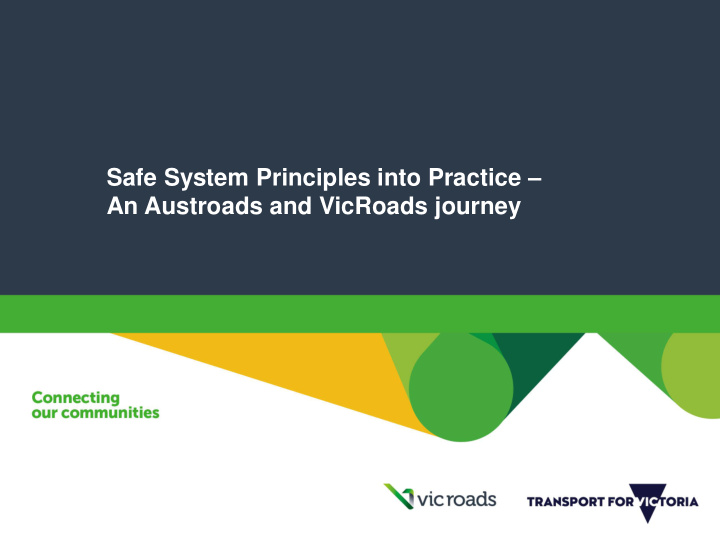



Safe System Principles into Practice – An Austroads and VicRoads journey
Who is Austroads? • Austroads’ purpose is to support our member organisations to deliver an improved Australasian road transport network. 2
Who is VicRoads? • VicRoads is the State Road Authority of Victoria, Australia. 3
Safe System Approach The Safe System approach was endorsed in Australia in 2003 by the Australian Transport Council and adopted by Austroads in 2006. The approach is now integral to road safety strategies in jurisdictions in Australia and New Zealand. 4
Safe System Principles 1. Humans are fallible and will inevitably make mistakes when driving, riding or walking. 2. Despite this, road trauma should not be accepted as inevitable. No one should be killed or seriously injured on our roads. 3. To prevent serious trauma, the road system must be forgiving, so that the forces of collisions do not exceed the limits that the human body can tolerate. 5
Safe System Pillars 6
Systems based thinking? Crash links can be broken in many places Infrastructure Vehicles Speed Road Users 7
How is the Safe System approach different? • Who is at fault, who is responsible? - The driver → the System designer and operator • What is the risk? - Accidents → Fatal and Serios Injury (harm) • What is the objective? - An optimal and economic number of fatalities and serious injuries → the virtual elimination of deaths and serious injuries. 8
Extreme 3% Rural Who is at fault? Illegal 10% Extreme: Accidental: - Excessive speeding - Lane departure & overcorrection - Alcohol and drugs - Evasive manoeuvre - Deliberate risk taking System - Lack of driver skill 87% Illegal: Extreme 9% Metro - Falling asleep / fatigue - Distraction Illegal 17% - Fail to stop OR give way - Driving too fast for the conditions System 74%
What is the risk? • Traditionally, engineers looked mainly at accident likelihood. • The Safe System approach, encourages engineers to assess injury. While we may not eliminate all accidents, we can minimise harm. Exposure Likelihood Severity Harm • Separation • Simplify • Speed • Route Planning • Recovery • Angle • No. of hazards • Impact severity 10
Severity – Safe Speeds 11
Severity – Safe Impact Angles 12
What is the objective? • The virtual elimination of harm. • To minimise harm as much as possible, more than the last job. • In practice, we needed: - A simple and user-friendly way to embed Safe System alignment. - A way to assist planners, designers and project managers to progress the Safe System approach from theory to practice. - A tool to compare project options from a Safe System perspective. 13
Safe System Assessments • Austroads Safe System Assessment Framework • VicRoads Safe System Assessment Guideline • Qualitative, rather than quantitative 14
Safe System Assessments 15
Safe System Assessment - Example 16
Safe System Assessment - Example 17
Safe System Assessment - Example Run-Off Run-Off Head-On Head-On Road Road 4 4 4 4 Exposure Exposure 3 2 3 3 Likelihood Likelihood 4 3 1 1 Severity Severity Total 48 24 Total 12 12 72 vs 24 18
Average scores of Safe System Assessments of 14 Major Projects in Victoria; worth ~$3.8 billion 70 60 Safe System Score (out of 64) 50 40 30 20 10 0 Run-off-road Head-on Intersection Other Pedestrian Cyclist Motorcyclist Existing Conditions Orignial Design Design after SSA 19
Safe System Assessments 20
Supporting Safe System in practice • Teaching Executive Leaders what to look for, • Providing improved standards and guidelines - Principles approach - Removing ‘road blockers’ – e.g. clear zones - Central barrier in narrow medians - Wide Centre Line Treatments - Audio Tactile Line Marking • Providing regular technical advice, • Providing regular information sessions – key stakeholders • Providing new products – safety barriers for motorcyclists 21
22
References • https://austroads.com.au • https://www.vicroads.vic.gov.au/business-and-industry/technical- publications • https://roadsafety.piarc.org/en/road-safety-management/safe- system-approach 23
Recommend
More recommend